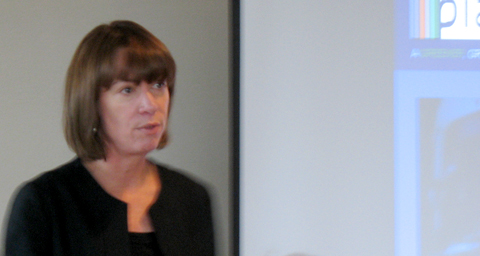An interview with Janette Sadik-Khan, commissioner of New York City’s Department of Transportation
An interview with Janette Sadik-Khan, commissioner of New York City’s Department of Transportation

We at TransLink were pleased to have Janette Sadik-Khan in Vancouver today and Monday!
Janette is New York City’s remarkable transportation commissioner, who has launched a slew of innovative projects since taking the position in 2007.
Pushing to accomplish the city’s PlaNYC 2030 strategic vision, Janette has closed Times Square to cars, created new bike lanes and public spaces in streets, launched a car-free Summer Streets festival, put in dedicated bus lanes, and more.
(I’m really not doing her justice – find out more on Janette’s work from these articles: New York Magazine, the Vancouver Sun, the Globe and Mail, Streetfilms, and Forbes.)
Anyway, Janette was able to share her experience with our cycling strategy stakeholder workshop, with the City of Vancouver, and with the public as part of SFU’s Shifting Gears lecture series (and the Gaining Ground, Resilient Cities conference).
I was also lucky enough to get a few minutes with her, so here’s a short interview.
You’ve put together some really challenging projects. What keeps you going with all this?
I’m a lifelong New Yorker, and I love my city. There is nothing more exciting than to improve the quality of life in the city that I love. I’m working for the best mayor in the world, and he’s pulled together a really good team. We’ve got an inspiring vision and an inspiring mayor, and I’ve got an incredibly talented team of 5,000 transportation professionals at New York City DOT. So it’s kind of a dream come true.
What were the biggest lessons that you learned from your projects? Were there any surprises?
I think the biggest surprise… well it’s not really a surprise. It was that New Yorkers feel very personally about public space. The space in front of their buildings, the space in front of their stores. It’s where life happens on the streets of New York. Everyone’s got a very strong opinion. It’s a city of 8.2 million and they’ve got 8.2 million points of view on how their city should go.
How do you handle that, when you hear this opposition?
Community outreach is really important. And our projects get better with input. So I really look at it as a conversation that helps us deliver better projects on the streets of New York.
What do you think other regions can learn from your projects?
Having a longer term vision is really important, and to nest the innovation that you’re looking to do as part of a strategic plan. We need to take longer looks at our cities in terms of where we want them to grow, how we want them to grow, to make sure that they’re designed and planned – that the projects that we build are the projects that will help move us to a greater greener world. At the same time, these projects don’t need to take 25 years to get done. And you can show some really quick turnaround on our projects, on any projects. With some paint and materials you can fill in the idea, the reality of how different the city can be.
What are your thoughts on transportation for the future?
I think that there is an increased recognition that transportation is broken, and we have to do it differently. And so whether it’s climate change, whether it’s the idea that we need to be more energy independent, or the fact that we’ve got incredible congestion on all our transportation systems, we need to do something different. We need to engine our streets differently. We need to build in more mobility, to our transportation networks. I think that the public gets that, and I think that in many ways they’re leading. They’re at the front of the line, asking for change.
Following from that, how should citizens view their streets? You’re really challenging the notion of what a street is. It’s not just for cars anymore. How should people individually view their streets?
Well, people will view their streets the way they want to view their street. We’ve taken a different approach, which is to view our streets as valuable public spaces. And that it’s not just about moving cars as quickly as possible. It is about building in public transit. It is about building places for social exchange. It is about improving the economic development in our cities. And a different approach to the streets accomplishes all that.






Love her ‘just try it’ actions. Instead of studying things for years she has gotten her city to try things out and judge the feedback. For example she has turned parking lots and side streets to seating areas for outdoor cafes or just to take a break outside. The majority of her changes has seen a mass increase of the public taking advantage of their neighbourhoods the way neighbourhoods should be used. And how does she section of the areas? With potted plants and paint. Quick to try, quick to remove.
Imagine for example if the city of Vancouver took that dead block thanks to the Sears monstrosity in downtown and every few months tried something different with it. They could try a row of food carts like Portland did successfully, the next month make it an area for buskers, the next invite book stalls and set up some benches. There are areas all over town that could try this approach.
[…] scored an interview with a speaker from New York’s Department of Transportation, Janette […]
[…] weeks ago, Janette Sadik-Khan, the Commissioner for the New York City Department of Transportation, visited Vancouver and shared her successes in transforming the state of mobility in […]
[…] the commissioner of the New York City Department of Transportation (she came to visit us last year!), gave a talk in L.A. — Streetsblog has more on what she […]